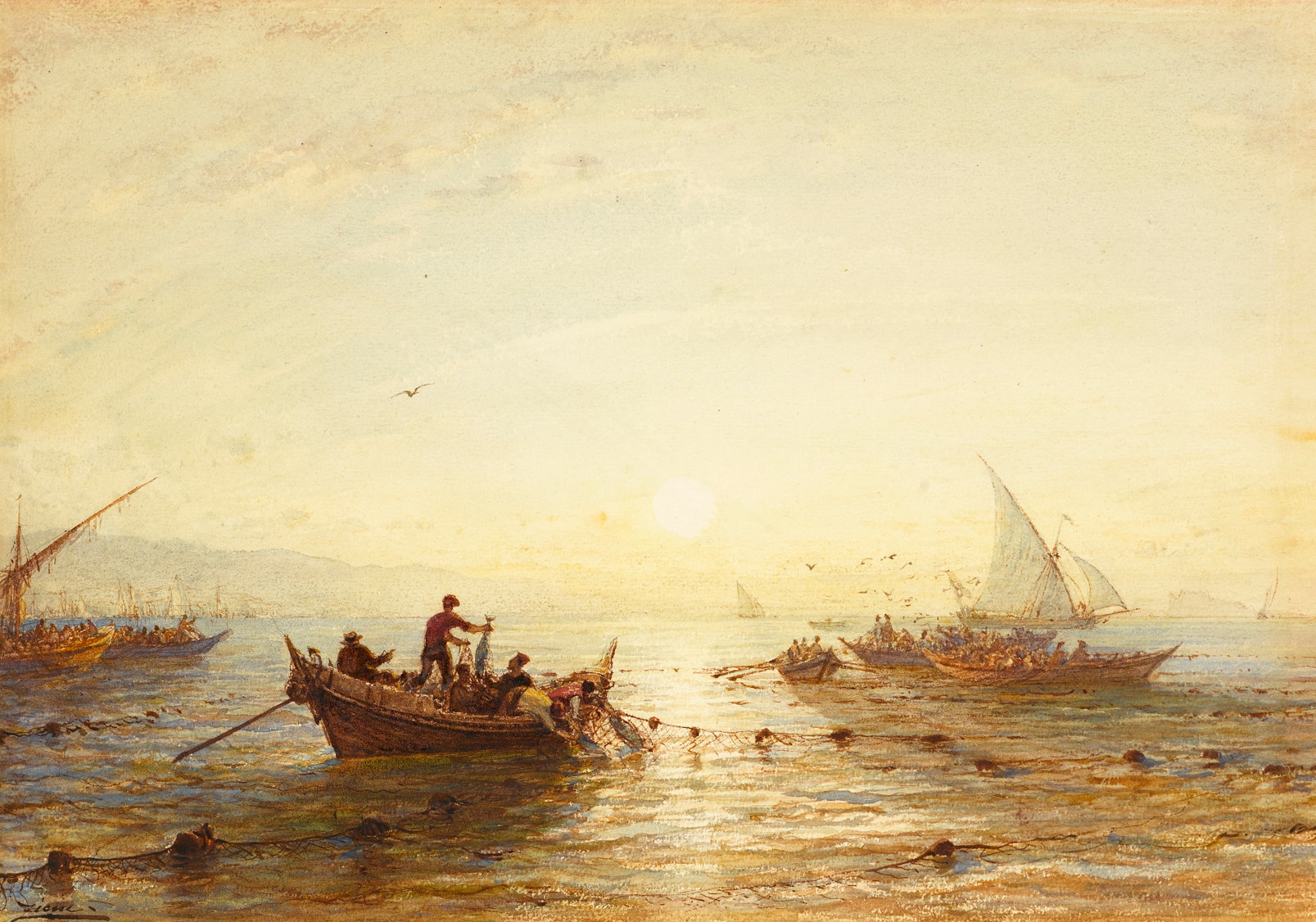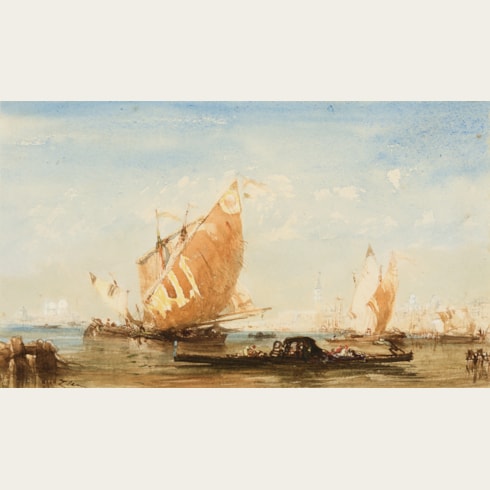Felix ZIEM
(Beaune 1821 - Paris 1911)
The Tuna Harvest at Sunset
Sold
Watercolour, red chalk and pen and brown ink, over an underdrawing in pencil.
Signed Ziem. at the lower left.
286 x 411 mm. (11 1/4 x 16 1/4 in.)
ACQUIRED BY THE NATIONAL GALLERY OF ART, WASHINGTON DC.
Signed Ziem. at the lower left.
286 x 411 mm. (11 1/4 x 16 1/4 in.)
ACQUIRED BY THE NATIONAL GALLERY OF ART, WASHINGTON DC.
In the spring of 1859 Ziem wrote in his journal of his fondness for the coastal landscapes of the south; ‘I am leaving for the Midi to do some work and make some observations…I think I'll see Sète, Martigues, Marseille, I'll do some sketches of the sea, of the mountains, of ships, some impressions capable of producing a result. And also, I haven’t seen this charming landscape for a year, my soul needs to open up and my body to breathe some salt air.’ Interestingly, he seems to have found the Provençal landscape more to his liking as a draughtsman rather than as a painter, as he noted in one of his sketchbooks a few years later, in 1865, ‘I have never produced beautiful paintings in the Midi, in spite of my expenses and efforts. I have done magnificent drawings there.’
The present sheet is closely related to a smaller watercolour of tuna fishermen, of an identical composition, in the collection of the Musée des Beaux-Arts de la Ville de Paris, at the Petit Palais in Paris, which also houses another watercolour of a tuna harvest at sunset, though of a different composition. Both Petit Palais watercolours are part of a large group of around a hundred works by Ziem, including paintings, watercolours and drawings, given by him to the museum in 1905.
Among other, similar watercolours of fisherman by the artist is one formerly in the Zoubaloff collection. Ziem also produced a handful of paintings of similar subjects, such as a painting of Martigues, pêcheurs à la Fouëne, today in the collection of the Musée Ziem at Martigues.
The attribution of this watercolour has been confirmed by Anne Burdin-Hellebranth.
The present sheet is closely related to a smaller watercolour of tuna fishermen, of an identical composition, in the collection of the Musée des Beaux-Arts de la Ville de Paris, at the Petit Palais in Paris, which also houses another watercolour of a tuna harvest at sunset, though of a different composition. Both Petit Palais watercolours are part of a large group of around a hundred works by Ziem, including paintings, watercolours and drawings, given by him to the museum in 1905.
Among other, similar watercolours of fisherman by the artist is one formerly in the Zoubaloff collection. Ziem also produced a handful of paintings of similar subjects, such as a painting of Martigues, pêcheurs à la Fouëne, today in the collection of the Musée Ziem at Martigues.
The attribution of this watercolour has been confirmed by Anne Burdin-Hellebranth.
Félix François Georges Ziem studied at the École d’Architecture et des Beaux-Arts in Dijon, where he won a prize for landscape drawing, before settling in Marseille in 1839. Early in his career, his skill as a watercolourist gained him the patronage of Ferdinand Philippe, Duc de Orléans. He soon achieved a fair degree of success as a painter, and began to travel – first around the South of France, where he was particularly taken by the landscape around the Provençal port town of Martigues – and later further afield. Indeed, Ziem was one of the most well-travelled artists of his day. He made the first of many trips to Italy in 1842, visiting Rome and Venice and returning to France via Germany and Austria. He met and befriended Prince Grigori Gagarin, and with him travelled to Russia between 1843 and 1844, visiting Odessa, Kiev, Moscow and St. Petersburg. He made his debut at the Salon in 1849, and continued to exhibit regularly until 1868. Ziem made countless trips throughout Europe, including a stay in England in 1852, and between 1856 and 1859 visited the Near East, working in Turkey, Egypt, Algeria and Tunisia. Ziem always remained particularly fond of Venice, which he visited some twenty times, and it is as a painter of Venetian views that he is best known today.
From around 1861 he settled in Martigues, though he continued to spend time in Nice, Paris and Venice. He enjoyed great success throughout the remainder of his career, selling his paintings for huge sums. His patrons included Princesse Mathilde, Baron de Rothschild and the Duke of Devonshire, and many of his paintings also found their way into important American collections in the late 19th century. A large group of paintings, watercolours and drawings by Ziem, presented by the artist in 1905, is today in the Musée du Petit Palais in Paris, while another substantial collection of his work is in the Musée Ziem in Martigues.
Félix Ziem was a prolific and gifted draughtsman and watercolourist, and from early in his career enjoyed an enthusiastic market for his watercolours among French collectors. Writing in the preface to a catalogue of a sale of thirty-four of Ziem’s watercolours in 1868, the critic Théophile Gautier compared him favourably to such English masters of the medium as J. M. W. Turner and Richard Parkes Bonington, further noting that one could experience the pleasures of visiting Venice, Marseille, the Mediterranean, Barbizon, Holland or Egypt by simply studying a portfolio of the artist’s watercolours.





